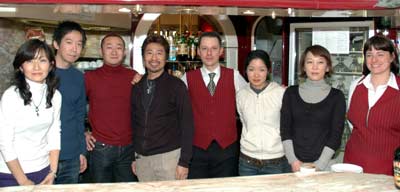I’ll be a barista when I grow up
by Roberto Sala
Barista. His bar, the Mary’s Bar in Costa Masnaga, in the North of Italy, was set up by his great-grandparents in 1928. He was brought up surrounded by machines, bags and cups. Fifteen years ago he started his job behind the counter: from 2001, he is a coffee taster and Espresso Italiano Specialist.In February 2007, he has been appointed to the board of the International Institute of Coffee Tasters. He is the first barista who has been appointed to such a role.
 I’m increasingly committed to training. Alongside my job at the coffee shop, I’m frequently asked to teach. Recently I had the opportunity to teach to a group of will-be barista who all started basically from scratch. People of all ages and without any experience. What to do when you find in front of yourself a bunch of pupils who have no idea whatsoever on the work they’re going to do? You start from the basics. This is the reason why I tried to teach them all the basics bearing in mind the fears and difficulties that learning a new job comes with. I taught them the basics of coffee-making, I introduced them to the machines, I told them when and how to use and clean them, and about the preparation of the product. We went, as much as the available time made it possible, into the very details and I tried, above all, to pass on to them my personal experience. I also taught them about aperitifs and cocktails but I preferred focusing on the preparation of coffee, stressing the rules of the International Institute of Coffee Tasters and the Italian Espresso National Institute. I had one thought in my mind: it was fundamental to me that the pupils understood the importance of espresso and especially that they understood that the coffee at the bar must trigger emotions in the client. The pupils had to face up to several difficulties many of them coming mainly from the fact that they had no knowledge of the machines. I also noticed a certain mistrust in their abilities and a bit of fear in facing a product they did not know. Time was against them: they had to learn everything in a few hours only. They were, however, supported by a strong desire to learn which reassured me. Beyond technical doubts, the pupils were all nervous for the start of their new business, some of them were afraid about not being able to face the client. How can you become self-confident in doing your job, how can you make sure that the client will come back? An ages-old question with a similarly ages-old answer: offer high quality products with kind manners.
I’m increasingly committed to training. Alongside my job at the coffee shop, I’m frequently asked to teach. Recently I had the opportunity to teach to a group of will-be barista who all started basically from scratch. People of all ages and without any experience. What to do when you find in front of yourself a bunch of pupils who have no idea whatsoever on the work they’re going to do? You start from the basics. This is the reason why I tried to teach them all the basics bearing in mind the fears and difficulties that learning a new job comes with. I taught them the basics of coffee-making, I introduced them to the machines, I told them when and how to use and clean them, and about the preparation of the product. We went, as much as the available time made it possible, into the very details and I tried, above all, to pass on to them my personal experience. I also taught them about aperitifs and cocktails but I preferred focusing on the preparation of coffee, stressing the rules of the International Institute of Coffee Tasters and the Italian Espresso National Institute. I had one thought in my mind: it was fundamental to me that the pupils understood the importance of espresso and especially that they understood that the coffee at the bar must trigger emotions in the client. The pupils had to face up to several difficulties many of them coming mainly from the fact that they had no knowledge of the machines. I also noticed a certain mistrust in their abilities and a bit of fear in facing a product they did not know. Time was against them: they had to learn everything in a few hours only. They were, however, supported by a strong desire to learn which reassured me. Beyond technical doubts, the pupils were all nervous for the start of their new business, some of them were afraid about not being able to face the client. How can you become self-confident in doing your job, how can you make sure that the client will come back? An ages-old question with a similarly ages-old answer: offer high quality products with kind manners.


